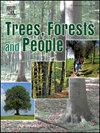Estimation of aboveground biomass of savanna trees using quantitative structure models and close-range photogrammetry
IF 2.7
Q1 FORESTRY
引用次数: 0
Abstract
In efforts to mitigate climate change and optimize resource management, the demand for accurate aboveground biomass (AGB) estimates has significantly increased. Traditional AGB estimation methods rely on allometric models, which have inherent limitations. Recent advancements in remote sensing technologies present new opportunities for obtaining precise and nondestructive AGB data. This study evaluated the accuracy of AGB estimates derived from close-range photogrammetry (CRP), comparing it with destructive sampling and allometric equations. Thirty trees from five Sudanian savanna species, spanning six diameter classes, were photographed with a handheld camera. Images were processed to reconstruct 3D models of the trees, from which tree volume was calculated using quantitative structure models (QSM) and converted to AGB with species-specific wood density. Agreement between reference and estimated AGB was assessed using coefficient of variation of root mean square error (RMSE%), mean absolute bias (MAB) and concordance correlation coefficient (CCC). CRP-derived AGB closely matched with reference data (RMSE% = 23.4%, CCC = 0.98, MAB = 241 kg) and outperformed pantropical (RMSE% = 81.6%, CCC = 0.62, MAB = 694 kg) and regional (RMSE% = 74.3%, CCC = 0.70, MAB = 640 kg) allometric models. Accuracy varied by tree size, with CRP performing best for trees with DBH ≥ 30 cm. These results demonstrate CRP's effectiveness in AGB estimation for Sudanian savanna trees and its potential for timely, accurate, and scalable assessments across diverse ecosystems.
利用定量结构模型和近景摄影测量估算稀树草原树木地上生物量
在减缓气候变化和优化资源管理的努力中,对准确估算地上生物量(AGB)的需求显著增加。传统的AGB估计方法依赖于异速生长模型,存在固有的局限性。遥感技术的最新进展为获得精确和无损的AGB数据提供了新的机会。本研究评估了近距离摄影测量法(CRP)估算AGB的准确性,并将其与破坏性采样和异速生长方程进行了比较。来自苏丹稀树草原5个物种的30棵树,跨越6个直径级,用手持相机拍摄了照片。对图像进行处理,重建树木的三维模型,利用定量结构模型(QSM)计算树木体积,并将其转换为具有物种特异性木材密度的AGB。采用均方根误差变异系数(RMSE%)、平均绝对偏倚系数(MAB)和一致性相关系数(CCC)评估参考与估计AGB之间的一致性。crp衍生的AGB与参考数据(RMSE% = 23.4%, CCC = 0.98, MAB = 241 kg)密切匹配,优于全热带(RMSE% = 81.6%, CCC = 0.62, MAB = 694 kg)和区域(RMSE% = 74.3%, CCC = 0.70, MAB = 640 kg)异速生长模型。准确性因树的大小而异,对于胸径≥30 cm的树,CRP表现最佳。这些结果证明了CRP在苏丹稀树草原树木AGB估计中的有效性,以及在不同生态系统中进行及时、准确和可扩展评估的潜力。
本文章由计算机程序翻译,如有差异,请以英文原文为准。
求助全文
约1分钟内获得全文
求助全文
来源期刊

Trees, Forests and People
Economics, Econometrics and Finance-Economics, Econometrics and Finance (miscellaneous)
CiteScore
4.30
自引率
7.40%
发文量
172
审稿时长
56 days
 求助内容:
求助内容: 应助结果提醒方式:
应助结果提醒方式:


